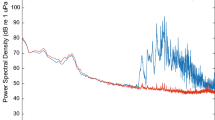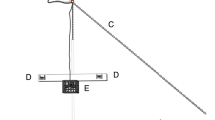Abstract
Acoustic communication is widespread among adult stages of terrestrial animals and fish and has also been observed in insect larvae. We report underwater acoustic communication in the larvae of a frog, Gephyromantis azzurrae, from Isalo, a sandstone massif in western Madagascar. According to our field data, these tadpoles live in streams and prefer habitats characterized by comparatively low temperatures, shallow water depth, and a relatively fast current. Feeding experiments indicated that the tadpoles are carnivorous and macrophagous. They consumed insect larvae and, to a lesser extent, small shrimps, and conspecific as well as heterospecific tadpoles. Calls of these tadpoles consisted either of single click notes or of irregular series of various clicks. Some complex calls have a pulsed structure with three to nine indistinct energy pulses. Production of the pulses coincided with rapid closure of the jaw sheaths and often with an upward movement of the body. Calls were emitted while attacking prey and occurred significantly more often when attacking conspecifics. Tadpoles that had not been fed for some time emitted sounds more frequently than those that had been regularly fed. The spectral frequency of the calls differed in tadpole groups of different size and was higher in groups of smaller tadpoles, suggesting that spectral frequency carries some information about tadpole size which might be important during competitive feeding to assess size and strength of competitors. This report differs from those for the larvae of South American horned frogs, Ceratophrys ornata. These are the only other tadpoles for which sound production has reliably been reported but the calls of Ceratophrys tadpoles occur mainly in a defensive context.


Similar content being viewed by others
References
Altig R, Whiles MR, Taylor CL (2007) What do tadpoles really eat? Assessing the trophic status of an understudied and imperiled group of consumers in freshwater habitats. Freshwater Biol 52:386–395
Amorim MCP, Hawkins AD (2000) Growling for food: acoustic emissions during competitive feeding of streaked gurnard. J Fish Biol 57:895–907
Amorim MCP, Stratoudakis Y, Hawkins AD (2004) Sound production during competitive feeding in the grey gurnard. J Fish Biol 65:182–184
Bass AH, Gilland EH, Baker R (2008) Evolutionary origins for social vocalization in a vertebrate hindbrain-spinal compartment. Science 321:417–421
Brown SG, Boettner GH, Yack JE (2007) Clicking caterpillars: acoustic aposematism in Antheraea polyphemus and other Bombycoidea. J Exper Biol 210:993–1005
Cocroft R, Ryan MJ (1995) Patterns of advertisement call evolution in toads and chorus frogs. Anim Behav 49:283–303
Crump ML (1995) Parental care. In: Heatwole H (ed). Amphibian biology. Vol. 2. Social behaviour. Surrey Beatty, Chipping Norton, pp. 518–567
Drosopoulos S, Claridge MF (eds) (2006) Insect sounds and communication: physiology, behaviour, ecology, and evolution. CRC, Boca Raton
Duellman WE, Trueb L (1986) Biology of amphibians. McGraw-Hill, New York
Feng AS, Narins PM, Xu CH, Lin WY, Yu ZL, Qiu Q, Xu ZM, Shen JX (2006) Ultrasonic communication in frogs. Nature 440:333–336
Fish MP (1954) The character and significance of sound production among fishes of the Western North Atlantic. Bull Bingham Oceanogr Collect 14:1–109
Fitch WT (2006) Production of vocalizations in mammals. In: Brown K (ed) Encyclopedia of language and linguistics. Elsevier, Oxford, pp 115–121
Gerhardt HC (1994) The evolution of vocalization in frogs and toads. Annu Rev Ecol Syst 25:293–324
Glaw F, Vences M (1994) A fieldguide to the amphibians and reptiles of Madagascar, 2nd edn. Vences and Glaw, Köln
Glaw F, Vences M (2006) Phylogeny and genus-level classification of mantellid frogs (Amphibia, Anura). Org Divers Evol 6:236–253
Grosjean S, Vences M, Dubois A (2004) Evolutionary significance of oral morphology in the carnivorous tadpoles of tiger frogs, genus Hoplobatrachus (Ranidae). Biol J Linn Soc 81:171–181
Hawkins AD (1993) Underwater sound and fish behaviour. In: Pitcher TJ (ed.) Behaviour of teleost fishes. Chapman & Hall, London, pp 129–169
Ladich F (1997) Agonistic behaviour and significance of sounds in vocalizing fish. Mar Freshw Behav Phy 29:87–108
Ladich F, Fine ML (2006) Sound-generating mechanisms in fishes: a unique diversity in vertebrates. In: Ladich F, Collin SP, Moller P, Kapoor BG (eds) Communication in fishes. Science, Enfield, pp 3–43
McDiarmid RW, Altig R (eds) (1999) Tadpoles: the biology of anuran larvae. University of Chicago Press, Chicago
Mercurio V, Andreone F (2007) Two new canyon-dwelling frogs from the arid sandstone Isalo Massif, central-southern Madagascar (Mantellidae, Mantellinae). Zootaxa 1574:31–47
Myrberg AA Jr (1997) Underwater sound: its relevance to behavioral functions among fishes and marine mammals. Mar Freshw Behav Phy 29:3–21
Narins PM, Lewis ER, McClelland BE (2000) Hyperextended call note repertoire of the endemic Madagascar treefrog Boophis madagascariensis (Rhacophoridae). J Zool London 250:283–298.
Narins PM, Grabul DS, Soma KK, Gaucher P, Hödl W (2005) Cross-modal integration in a dart-poison frog. Proc Natl Acad Sci USA 102:2425–2429
Narins PM, Feng AS, Fay RR, Popper AN (eds) (2006) Hearing and sound communication in amphibians. Springer handbook of auditory research, vol. 28
Natale GS, Alcalde L, Herrera R, Cajade R, Schafer EF, Marangoni F, Trudeau VL (2010) Underwater acoustic communication in the macrophagic carnivorous larvae of Ceratophrys ornata. Acta Zool Stockholm. doi:10.1111/j.1463-6395.2009.00445.x
Parmentier E, Colleye O, Fine ML, Frédérich B, Vandewalle P, Herrel A (2007) Sound production in the clownfish Amphiprion clarkii. Science 316:1006
Podos J, Huber SK, Taft B (2004) Bird song: the interface of evolution and mechanism. Annu Rev Ecol Evol Syst 35:55–87
Polis GA, Myers CA (1985) A survey of intraspecific predation among reptiles and amphibians. J Herpetol 19:99–107
Popper AN, Salmon M, Horch KW (2001) Acoustic detection and communication by decapod crustaceans. J Comp Physiol A 187:83–89
R Development Core Team (2009) R: a language and environment for statistical computing. R Foundation for Statistical Computing, Vienna
Randrianiaina RD, Glaw F, Thomas M, Glos J, Raminosoa N, Vences M (2007) Descriptions of the tadpoles of two species of Gephyromantis, with a discussion of the phylogenetic origin of direct development in mantellid frogs. Zootaxa 1401:53–61
Ruibal R, Thomas E (1988) The obligate carnivorous larvae of the frog, Lepidobatrachus laevis (Leptodactylidae). Copeia 1988:591–604
Ryan MJ (1988) Constraints and patterns in the evolution of anuran acoustic communication. In: Fritzsch B, Ryan MJ, Wilczynski W, Hetherington TE, Walkowiak W (eds) The evolution of the amphibian auditory system. Wiley, New York, pp 637–677
Seale DB, Wassersug RJ (1979) Suspension feeding dynamics of anuran larvae related to their functional morphology. Oecologia 39:259–272
Strauß A, Reeve E, Randrianiaina RD, Vences M, Glos J (2010) The world’s richest tadpole communities show functional redundancy and low functional diversity: ecological data on Madagascar’s stream-dwelling amphibian larvae. BMC Ecol 10:12
Sueur J, Aubin T, Simonis C (2008) Seewave: a free modular tool for sound analysis and synthesis. Bioacoustics 18:213–226
Vaz-Ferreira R, Gehrau A (1975) Comportamiento epimeletico de la rana comum, Leptodactylus ocellatus (L.) (Amphibia, Leptodactylidae) I. Atencion de la cria y actividades alimentarias y agresivas relacionadas. Physis 34:1–14
Wells KD (1977) The social behaviour of anuran amphibians. Anim Behav 24:666–693
Westneat MW, Socha JJ, Lee WK (2008) Advances in biological structure, function, and physiology using synchrotron x-ray imaging. Annu Rev Physiol 70:119–142
Yack JE, Smith ML, Weatherhead PJ (2001) Caterpillar talk: acoustically mediated territoriality in larval Lepidoptera. Proc Natl Acad Sci USA 98:11371–11375
Yager DD (1992) A unique sound production mechanism in the pipid anuran Xenopus borealis. Zool J Linn Soc 104:351–375
Acknowledgments
We are grateful to Parfait Bora, Liliane Raharivololoniaina, and Katharina Wollenberg for their assistance in the field, and to Angelica Crottini and Solohery Rasamison for their attempt to perform additional experiments in 2009, hampered by the lack of rain in that year. This work has been carried out in the framework of various collaboration agreements with the Université d’Antananarivo, Département de Biologie Animale, and we are grateful to Noromalala Raminosoa, Olga Ramilijaona, and Daniel Rakotondravony for continued support. The Malagasy authorities kindly granted research and export permits. This work was carried out in the framework of a project of the Deutsche Forschungsgemeinschaft (grant VE247/2-1) and further supported by the Volkswagen Foundation.
Author information
Authors and Affiliations
Corresponding author
Supplementary online materials
Sequence of video scenes showing sound production in tadpoles of Gephyromantis azzurrae.
Video sequence showing a tadpole of G. azzurrae following a small crustacean (Gammaridae) and attacking it multiple times (MPG 9,678 kb)
Video sequence showing a tadpole of G. azzurrae attacking a small crustacean (Gammaridae) and swallowing it (MPG 5,654 kb)
Video sequence showing an intensive fight between two tadpoles of G. azzurrae of similar sizes, both emitting complex calls (of partly very fast note repetition rate) during the fight (MPG 8,868 kb)
Video sequence showing a tadpole of G. azzurrae attacking a semitransparent silicone tadpole model that is moved in front of the tadpole, and emitting calls during the attack (MPG 9,764 kb)
Rights and permissions
About this article
Cite this article
Reeve, E., Ndriantsoa, S.H., Strauß, A. et al. Acoustic underwater signals with a probable function during competitive feeding in a tadpole. Naturwissenschaften 98, 135–143 (2011). https://doi.org/10.1007/s00114-010-0752-1
Received:
Revised:
Accepted:
Published:
Issue Date:
DOI: https://doi.org/10.1007/s00114-010-0752-1




